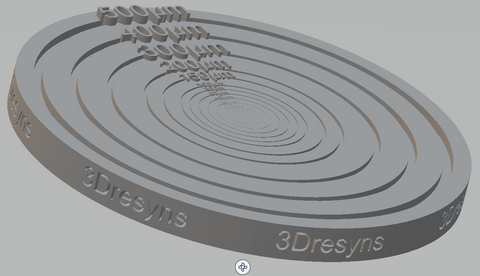Fine Tuning additives for custom fine tuning of printing speed, resolution, precision, and dimensional accuracy

The majority of our 3D resins come as standard ready to print with a broad range of SLA, DLP & LCD printers and for most printing technologies providing the light source wavelength is between 250-410 nm (higher wavelengths are also available):
Approximately 90 to 95% of our resins printability will come straight out of the bottle as supplied. You will be pleased to find that even then, the performance (printability and mechanical properties) far exceeds our competitor’s resins in most printers.
Our 3Dresyns can be fine tuned even further with our photoaccelerants (photocatalysts) and resolution increasers (resolutioners) for self-tuning their printing speed, resolution, precision, and dimensional accuracy with different printer types and printing settings, such as specific light power, exposure time per layer, and z layer thickness.
Free samples of our photoaccelerant (photocatalyst) Fine Tuner FT1 and of our resolutioner Fine Tuner LB1 Bio will be sent for self-tuning if necessary and upon request to provide maximum control and balance of printing speed, xyz resolution, precision, and dimensional accuracy.
3Dresyns is the first and only company up to date that supplies:
- Fine Tuners for custom control of printing speed and dimensional accuracy
- Scientific Instructions for Use IFU and calibration files (see above the flat coin with supports) for measuring and optimising the dimensional accuracy in the 3 dimensions, the x, y, and z axis.
For more info read: The difference among resolution, precision, and dimensional accuracy
As rule of thumb the higher the printing speed, the lower the resolution, precision, and dimensional accuracy of prints. Consequently, printing speed needs to be balanced with the right dosage of resolutioner to get optimum balance of printing speed and accuracy.
The higher the printing speed the lower the resolution, precision, and dimensional accuracy of prints.
Printing speed can be custom adjusted by fine tuning our 3D resins to most printers with:
- Fine Tuner FT1 is our favourite photo accelerant (photocatalyst) recommended for increasing the cure speed of our resins in printers working with UV/Visible light wavelengths up to 410 nm (250-410 nm range), including 405 nm blue Light-emitting Diodes "LED", lasers and standard DLP projectors, and LCDs
- If you are printing opaque colored 3Dresyns with very low power 3D printers or with uv/visible wavelengths up to 420 nm our Fine Tuner FT2 can also be used
- If you are printing biocompatible 3Dresyns Fine Tuner FT2P is recommended due to its ultra high hidrophobicity and extremely low water solubility and extractability, despite its lower resolution than Fine Tuner FT1
- Fine Tuner FT4 Bio HP and Fine Tuner FT4 Bio are our 100% biocompatible photo accelerants (photocatalysts) specially recommended for increasing the cure speed of our 3Dresyns in printers working with Ultraviolet and Visible lights from 250 nm up to 500 nm: including the far, medium and near UV range, as well as the visible range (daylight), including visible lasers, LEDS, DLP projectors, and daylight visible light sources from 250 nm up to 500 nm, with the benefit of not having any safety issues. Both are ideal for printing biocompatible systems since are ultra safe, not cytotoxic and 100% biocompatible (without any warning labels/ pictograms)
- If you need ultra safe water soluble biocompatible and bio-based photo accelerants (photocatalysts) discover: Fine Tuner FT5 Bio WS
- It is recommended the use of Fine Tuners FT in steps of 0.1% in high power printers (strong laser and high power DLP printers) and of 0.5-1% in low power printers (LCD & MLCD printers) to increase gradually printing speed. Avoid over dosage to avoid overcure of the resin beyond limits/specifications, resulting in potential loss of resolution, precision, and dimensional accuracy of your prints

- Fine Tuner LB1 Bio is our recommended biocompatible resolution-er for improving xyz resolution, precision, and dimensional accuracy of our 3D resins in printers working with lights from 350 to 410 nm, including 405 nm blue LEDs, lasers and standard DLP projectors, and LCDs. It is a 100% safe biocompatible resolution increaser. An ultra low water absorption version is also available: Fine Tuner LB1 Bio ULWA
- Fine Tuner LB2 Bio is our fluorescence free 100% safe biocompatible clear resolution-er. An ultra low water absorption version is also available: Fine Tuner LB2 Bio ULWA
- Fine Tuner LB Cyan is our cyan colored resolution-er for improving resolution, precision, and dimensional accuracy of 3D resins
- Fine Tuner LB Black is our black colored resolution-er for improving resolution, precision, and dimensional accuracy of 3D resins
- It is recommended the use of Fine Tuners LB in increasing steps of 0.3-0.5% to improve the resolution and accuracy of your prints in your specific printer settings
Note: Instructions for Use IFU are sent upon request for selecting the best printing settings of our resins in your specific printer. After placing your order request our IFU by email to: info@3dresyns.com
The following figure clearly shows the difference among resolution, precision, and dimensional accuracy:
Examples of measurements with low and high accuracy, precision, and resolution. The center represents the true value and each yellow dot is a measurement sample (Source: How to Calculate with Uncertainty)
In our case, resolution refers to the smallest concentric circle line printed on the surface of the printed coin and to the printed micrage in relief (see image below), since each circle line has engraved (and written in stereo the micrage) its width and depth in decreasing order from 500 to 2 microns.


